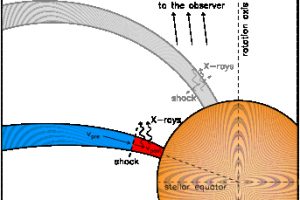A detailed view of the accretion process onto pre-Main Sequence stars. Published on A&A the study: “Redshifted X-rays from the material accreting onto TW Hydrae: Evidence of a low-latitude accretion spot” of C. Argiroffi

Pre-Main Sequence stars (which are still contracting and whose nucleus is still not hot and dense enough to ignite the nuclear fusion) are often observed surrounded by a disc of gas and dust called protoplanetary discs. Among the reasons why it is crucial to study these discs, it must be cited the fact that they are the environment of planet formation and they can play an important role in the early stellar evolution. In particular, accretion of gas from the disc to the central star can last several million years after the star formed.
The accretion process is the most important process of magnetic stellar-disk interaction. Close enough to the central star (e.g. a few fractions of astronomical unit, which is the average Earth-Sun distance, about 150 million of km), in fact, the disc is hotter than 1000 degrees. With such high temperature, its ionization fraction is large enough to allow for an efficient coupling with the stellar magnetic field. In this inner region of discs, thus, the stellar magnetic field can dominate the gas dynamic, funneling it along its field lines and make it fall onto the central star at almost free-fall velocity (few hundreds km/sec). When the accreting gas hits the stellar surface and it suddenly stops (shock region), its temperature rise over few million degrees, heating also the surrounding region (the accretion hot spot), and becoming a source of X-ray and UV emission.
How can we analyze the accretion process and its geometry given that it is not possible to resolve the innermost region of discs, not even in those closer to our Sun? One possibility is to take advantage of the wave nature of light, and the fact that the light emitted by a source moving with respect an observer is affected by the Doppler effect. In principle it is possible to detect the Doppler effect on the X-ray and UV emission from the gas after the shock region (the post-shock region) and use it to measure its velocity with respect to the stellar surface.
This complex technique has been successfully adopted for the first time in the study: “Redshifted X-rays from the material accreting onto TW Hydrae: Evidence of a low-latitude accretion spot” of C. Argiroffi (University of Palermo), recently published by Astronomy & Astrophysics. The authors of the paper succeeded in measuring the velocity of the 2-4 million degrees gas in the post-shock region (about 38 km/sec) on the accreting star TW Hydrae by measuring the Doppler effect in its X-ray emission. This also allowed them to estimate the latitude of the hot spot, being between 10 and 30 degrees. If applied to a large sample of accreting stars, this technique will allow us to achieve a more detailed view of the accretion process onto pre-Main Sequence stars.
The figure (link) shows a schematic view of the geometry of the accretion process on TW Hydrae.
